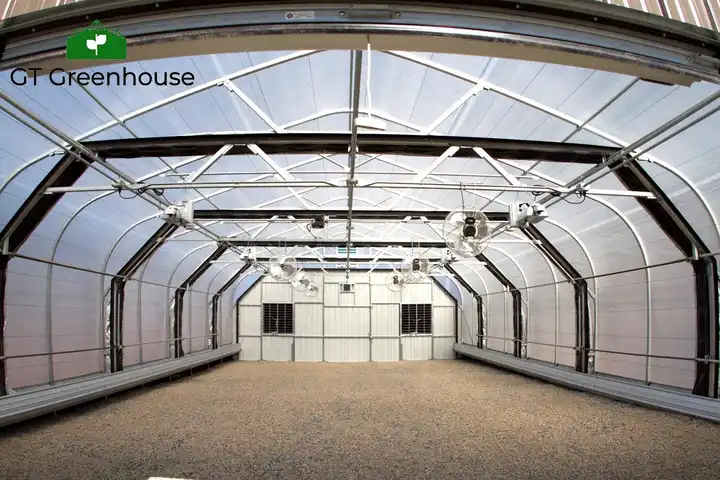Tomatoes are a beloved staple in kitchens worldwide, and the demand for fresh, flavorful tomatoes continues to rise. To meet this demand, innovative farming techniques have emerged, with tomato greenhouses taking center stage. These controlled environments provide optimal conditions for tomato cultivation, ensuring year-round production and superior quality.

What is A Tomato Greenhouse ?
A tomato greenhouse is a structure specifically designed for the cultivation of tomatoes. It provides an environment that allows optimal growth and production of tomato plants. Greenhouses are often made of transparent materials like glass or plastic to allow sunlight to enter while trapping heat inside.A tomato greenhouse is also a specially designed structure that allows growers to create a tailored microclimate for their tomato plants. By harnessing the power of sunlight, temperature control, and irrigation systems, these greenhouses offer a nurturing environment that promotes healthy growth and maximizes yield.
The key features of a tomato greenhouse include:
- Temperature Control: Greenhouses allow farmers to regulate the temperature inside by using ventilation systems, fans, and shading techniques. This ensures that the temperature remains within the ideal range for tomato growth, even during extreme weather conditions.
- Humidity Control: Maintaining proper humidity levels is crucial for the health and productivity of tomato plants. Greenhouse structures often incorporate automatic misting or fogging systems to control humidity and create a favorable microclimate.
- Ventilation: Good air circulation is essential for preventing the buildup of moisture, controlling temperature, and reducing the risk of diseases. Greenhouses are equipped with ventilation systems, including vents, fans, and louvers, to ensure adequate airflow.
- Irrigation Systems: Efficient water management is vital for tomato cultivation. Greenhouses are equipped with irrigation systems that deliver water directly to the plant roots, minimizing waste and optimizing water usage.
- Pest and Disease Management: Greenhouses act as a physical barrier, protecting tomato plants from pests, insects, and diseases. Integrated pest management strategies, such as biological controls and monitoring systems, are commonly employed to minimize the use of chemical pesticides.
- Lighting: In regions with limited sunlight or during the winter months, supplemental lighting systems can be installed in greenhouses to provide the necessary light energy for tomato plants. This ensures consistent growth and development throughout the year.
By providing a controlled environment, green house for tomato offer numerous advantages, including extended growing seasons, increased yields, protection from adverse weather conditions, improved pest and disease control, and enhanced water and resource management. These benefits contribute to the production of high-quality tomatoes with greater efficiency and sustainability.
What are the Benefits of Greenhouse Tomatoes ?
Greenhouse tomatoes offer several benefits compared to tomatoes grown in open fields. Here are some of the advantages:
- Extended Growing Season: Greenhouses provide a controlled environment, allowing tomatoes to be grown throughout the year regardless of the external weather conditions. This extends the growing season and ensures a continuous supply of fresh tomatoes, even in regions with short or unpredictable growing seasons.
- Protection from Adverse Weather: Greenhouses shield tomato plants from extreme temperatures, heavy rainfall, strong winds, and hailstorms. This protection reduces the risk of crop damage and allows for consistent growth and development.
- Pest and Disease Control: Greenhouses create a physical barrier that helps prevent pests, insects, and diseases from reaching tomato plants. This reduces the need for chemical pesticides and minimizes the risk of crop loss due to infestations.
- Improved Water Management: Greenhouses enable better control over water usage by providing irrigation systems that deliver water directly to the plant roots. This reduces water waste and allows for efficient water management, resulting in healthier and more productive tomato plants.
- Enhanced Yield and Quality: The controlled environment of greenhouses provides optimal conditions for tomato plants to grow, resulting in higher yields and better-quality tomatoes. Factors like temperature, humidity, lighting, and fertilization can be carefully regulated to maximize productivity and flavor.
- Efficient Space Utilization: Greenhouses allow for vertical farming techniques, such as trellising and training tomato plants to grow upwards. This maximizes the use of available space and increases overall production per square meter of the greenhouse.
- Reduced Dependency on Chemicals: By controlling the growing environment and minimizing pest and disease pressure, greenhouse tomato cultivation can reduce the reliance on chemical pesticides and fertilizers. This promotes more sustainable and environmentally friendly farming practices.
- Consistent Crop Supply: Greenhouse tomatoes can be cultivated in a controlled manner, ensuring a consistent and reliable supply of fresh tomatoes throughout the year. This benefits consumers, retailers, and food service industries that require a stable source of tomatoes.
Green House and Operation for Growing Tomatoes
When it comes to growing green house tomatoes, Chinese style greenhouses have gained popularity. These structures incorporate traditional Chinese architectural elements, blending aesthetics with functionality. Chinese style greenhouses are known for their efficient use of space, allowing for high-density planting and maximizing yield per square meter.
To further optimize tomato green house operations, the implementation of greenhouse blackout systems has proven invaluable. These systems allow growers to regulate light exposure, creating ideal conditions for tomato plants at different growth stages. By controlling the duration and intensity of light, blackout systems promote proper flowering, fruit setting, and ripening, resulting in higher-quality tomatoes.
Innovation in Greenhouse Design
Another innovative feature in greenhouse design is the open roof concept. Open roof greenhouses provide natural ventilation, allowing for better air circulation and temperature control. This design element helps prevent the buildup of excessive heat and humidity, reducing the risk of diseases and improving overall plant health.
In short, tomato greenhouses have revolutionized the way we grow and consume tomatoes. With their ability to provide a controlled environment, protect against external factors, and optimize growth conditions, greenhouse tomatoes offer a sustainable solution to meet the increasing demand for fresh, flavorful tomatoes. Whether it’s a Chinese style greenhouse, equipped with blackout systems or an open roof design, these innovative structures pave the way for efficient and eco-friendly tomato cultivation. Embrace the future of farming and enjoy the bountiful harvest of greenhouse-grown tomatoes.